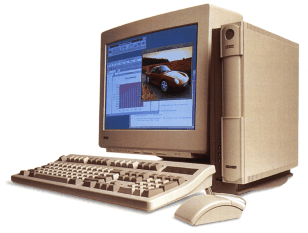| cosam.org |
Digital Multia

| Model: | Digital Multia VX40B-F2 |
| In service since: | March 2002 |
| OS: |
Debian |
| Function: | Doorstop (was gateway/firewall) |
Specs
- 166 Mhz Alpha 21066 (LCA) CPU
- 32 Mb RAM
- 256 Kb cache
- 340 Mb Toshiba MK1824FBV SCSI-2 Hard Disk (2.5")
- 10 Mbps DECchip 21040-AA Network Interface
- DECchip ZLXp 21030 Display Driver
- 8" IBM Monochrome Monitor

Character Traits
Multias are almost infamous for their unreliability, and
"heat death ![]() "
is supposedly pretty common.
I therefore replaced the puny factory-fitted fan with a meatier model, and put a heatsink on the
74623 chip. Unfortunately, I had the fan blowing air over the CPU to start with, and the machine
started to cut out and make strange clicking noises when the weather got warmer. I then fitted it
the other way round, drawing the hot air from inside the box outwards, so the machine ran pretty
cool. Unfortunately this machine is now very unreliable and hangs making a strange clicking noise
every now and again. I therefore took it out of service and raided it for parts for other machines.
"
is supposedly pretty common.
I therefore replaced the puny factory-fitted fan with a meatier model, and put a heatsink on the
74623 chip. Unfortunately, I had the fan blowing air over the CPU to start with, and the machine
started to cut out and make strange clicking noises when the weather got warmer. I then fitted it
the other way round, drawing the hot air from inside the box outwards, so the machine ran pretty
cool. Unfortunately this machine is now very unreliable and hangs making a strange clicking noise
every now and again. I therefore took it out of service and raided it for parts for other machines.
Expandability was not the top priority for the designers of this little machine. There is one rather delicate-looking PCI riser board, which cannot be used in conjuction with an optional 3.5" hard disk. In my example, even the CPU is soldered to the motherboard. Some models (not this one) have an expandable cache.
Mods
- 15.5 f3/m Fan
- Heatsink on 74623 chip
- 10/100 Mbps 3com 3c905 PCI NIC
Installation and Configuration
The Debian installation boot disk didn't work, so I used one from Red Hat 7.1 with the Debian RAM disk image. However, as this machine has no CD-ROM drive, I still needed the modules for the 2.4 Red Hat kernel to get networking up and install via HTTP. I got these from the Red Hat RAM disk image - this can be gunzipped and mounted as an ext2 filesystem through a loopback device. The modules can then be extracted from the cpio archive in this filesystem.
The installation itself is very minimal - just enough to get networking, SSH access and iptables-based firewalling/NAT up.